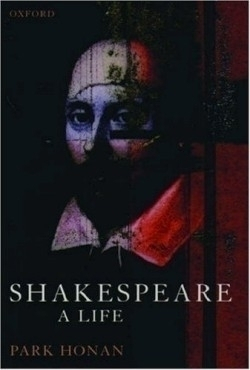Shakespeare
A Life
In an age that is virtually a second Renaissance of Shakespearean appreciation, it is testament to his infinite variety that the man himself remains as elusively mandarin as ever, and his grave’s inscription as minatory: “Curst Be He That Moves My Bones.” The followers of William Shakespeare are sharply divided. Cultural materialists, taking the low road from Stratford-upon-Avon to London’s plague-closed theatres and back to Stratford, have faced a dearth of correspondence, making do with the tantalizing runes of wills and only-recently unearthed public records. The high road to artistic apotheosis (first blazed by the Romantics; most lately by Harold Bloom’s “Bardolotrous” Shakespeare: The Invention of the Human) is still preferred by those who believed their poet’s words should be deeply read, but rarely ever seen or heard.
Mandated by fact, yet possessing a keen nose for the habits of noble and artisan classes, Park Honan’s Shakespeare: A Life is a welcome Baedeker of a biography, a scrupulous blend of family-history research and political context that never forgets the common reader. He puts fresh English air around the plays’ origins. For instance, James VI of Scotland, Protestant yet superstitious, author of a book on demonology, in his coronation as James I of England was greeted by three Oxford boys dressed as Sibyls, hailing him King of Scotland, and a descendant of the Scottish warrior Banquo. Months later Guy Fawkes and his Gunpowder Plot to blow up Parliament resulted in several Warwickshire gentry (including Catholics known to Shakespeare) being hanged. Though he cautions that Shakespeare was too canny to brazenly antagonize his royal patron, the imagination of Macbeth (and the history of witchcraft) is a potent blend of realism and myth.
Calling it “alternative narrative,” Honan follows a Lancashire nobleman’s bequest to his half-brother’s plan to keep an acting troupe: “Instrumentes and playe clothes” to “william Shakeshafte.” Shakespeare or Zelig? How Shakespeare came to London eludes the biographer binoculars. Yet even he cannot resist opining beyond his brief: “The most tangled and contradictory of his relationships, one suspects, was always with his mother. His troubled attitudes to women are too deep to be of anything but early origin.” But Shakespeare holds up a Hamlet glass, becoming Everyman, disappearing into character.
It seems the highest compliment to say of Honan (Emeritus Professor of the University of Leeds, and biographer of Jane Austen and Matthew Arnold, among others) that Shakespeare might indeed recognize himself in this volume, signing last will, entailing his considerable land holdings to a yet-unborn male heir of his two daughters (his son Hamnet long since dead) who never was to be. What he never dreamed was his Globe Theatre being excavated and now presenting matinees. A Renaissance indeed.
Reviewed by
Leeta Taylor
Disclosure: This article is not an endorsement, but a review. The publisher of this book provided free copies of the book to have their book reviewed by a professional reviewer. No fee was paid by the publisher for this review. Foreword Reviews only recommends books that we love. Foreword Magazine, Inc. is disclosing this in accordance with the Federal Trade Commission’s 16 CFR, Part 255.

